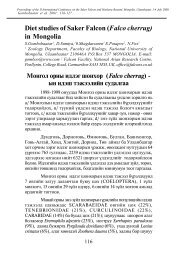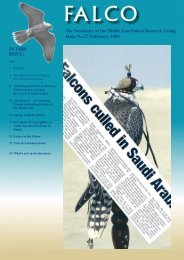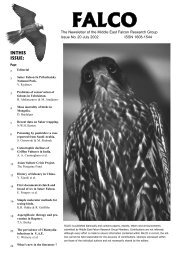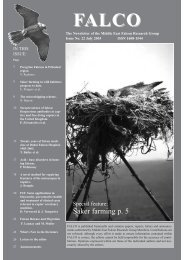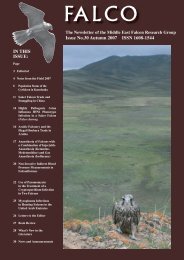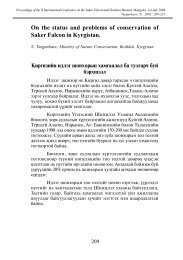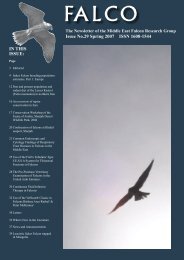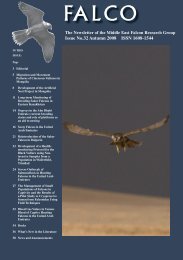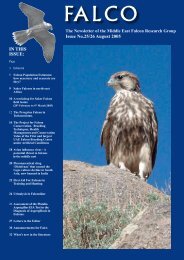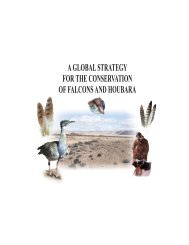Falco 28 - International Wildlife Consultants Ltd.
Falco 28 - International Wildlife Consultants Ltd.
Falco 28 - International Wildlife Consultants Ltd.
You also want an ePaper? Increase the reach of your titles
YUMPU automatically turns print PDFs into web optimized ePapers that Google loves.
ca. 75 m to the east. The Barbary <strong>Falco</strong>n stood on a<br />
big ledge in shadow, whilst the Saker was stood in the<br />
shade of a 2 m long niche in the rocks. The two birds<br />
stayed in their respective positions for one hour without<br />
flying or giving any vocal activity. At the beginning<br />
of the observation a male Common Kestrel, probably<br />
breeding on the same cliff, attacked the Barbary <strong>Falco</strong>n<br />
twice. In comparison with the male Common Kestrel<br />
the Barbary <strong>Falco</strong>n was only about 1.5 times bigger,<br />
with this size difference being more noticeable in the<br />
width of the breast than in the length of the body.<br />
between Sakers and Barbary <strong>Falco</strong>ns in the wild. In<br />
fact, the only reference to hybridisation involving<br />
wild Saker <strong>Falco</strong>ns comes from Slovakia where a wild<br />
female apparently produced offspring with a Peregrine<br />
x Saker hybrid; a further six instances of assumed crossbreeding<br />
with hybrids have been claimed in Slovakia<br />
(Nagy & Demeter, 2005).<br />
Description of the Barbary <strong>Falco</strong>n: grey back and<br />
wings, breast and belly cream-coloured with very fine<br />
barring on the upper sides of the trousers and left and<br />
right side of the belly. Eyebrows and nape rufous,<br />
connecting each other. The top of the head was dark<br />
brown, moustaches black and very distinctive, sharply<br />
contrasting with the white cheek. The legs and cere<br />
were bright yellow. Description of the Saker <strong>Falco</strong>n:<br />
brown back and wings, white nape, dark forehead,<br />
bright white eyebrows, white breast without any spots,<br />
streaked with big brown spots on the trousers and the<br />
lower part of the belly.<br />
On the 17th May, IA, LL and Istvan Balasz observed<br />
the nest for 4 hours from 11:00. During this period no<br />
large falcons were seen. The nest was checked and it<br />
was clear that the eggs had been abandoned as they<br />
were cold and partly covered with branches from the<br />
old eagle nest. Two pairs of Lesser Kestrels and a pair<br />
of Common Kestrels were observed at the same cliff.<br />
On the <strong>28</strong>th May we visited the nest site in order to<br />
weigh and measure the deserted eggs but unfortunately<br />
they had been eaten by a predator. There were broken<br />
shell fragments in the nest but no evidence of any<br />
embryo formation could be seen. The shell colour was<br />
still bright suggesting that they hadn’t been incubated.<br />
Whilst we were in the nest area a single Saker was seen<br />
flying high about one km NE from the nest.<br />
At no time during any of the above visits was a pair of<br />
Saker <strong>Falco</strong>ns seen at the nesting site. A comparison of<br />
size between the Saker and the Barbary <strong>Falco</strong>n seen at<br />
the nest site suggests that the Saker was a male bird and<br />
the Barbary <strong>Falco</strong>n was a female.<br />
Possible scenarios to explain our observations are:<br />
(i) there was initially a normal pairing of a male and<br />
female Saker <strong>Falco</strong>n that resulted in the production of<br />
a clutch of four eggs but the female Saker subsequently<br />
died and was temporarily replaced by a female Barbary<br />
<strong>Falco</strong>n, or (ii) that this was a mixed-species pairing<br />
resulting in the production of a clutch of eggs laid by a<br />
female Barbary <strong>Falco</strong>n. In captivity hybrids have been<br />
produced through crossing Saker <strong>Falco</strong>ns with Barbary<br />
<strong>Falco</strong>ns, both via artificial insemination and copulation,<br />
but a recent review of avian hybrids (McCarthy, 2006)<br />
did not report any documented cases of hybridisation<br />
Figure 1. Barbary <strong>Falco</strong>n photographed in NW China.<br />
(Ma Ming)<br />
In places where the breeding ranges of Saker <strong>Falco</strong>ns<br />
and Barbary <strong>Falco</strong>ns overlap (i.e., parts of Asia Minor<br />
and Central Asia) there are few observers so the<br />
chances of a mixed species pairing being detected is<br />
low. Nevertheless, it is reasonable to assume that Saker-<br />
Barbary <strong>Falco</strong>n pairings are rare and that behavioural<br />
and ecological differences generally prevent the two<br />
species forming pair bonds. Our study area in the<br />
eastern Junggar Basin lies outside the normal breeding<br />
range of the Barbary <strong>Falco</strong>n in north-west China, thus<br />
any female here is less likely to find a mate of its own<br />
kind. A lack of available conspecific mates is regarded<br />
as one of the prime causes of hybridisation in wild birds<br />
(McCarthy, 2006). ‘Natural pairings’ in captivity show<br />
that behavioural barriers to Saker-Barbary <strong>Falco</strong>n pair<br />
formation and copulation can be surmounted. However,<br />
in the wild there is a marked dietary difference<br />
between Sakers and Barbary <strong>Falco</strong>ns, with the former<br />
preying predominantly on mammals and the latter<br />
feeding principally on birds. This dietary difference<br />
may make mixed-species pairings between the two<br />
species difficult to sustain and reduce the likelihood of<br />
successful hybridisation.<br />
References<br />
Nagy, S. and Demeter, I. 2005. Saker <strong>Falco</strong> cherrug<br />
European Single Species Action Plan. 3 rd draft, Sept.<br />
2005.<br />
McCarthy, E (2006) Handbook of Avian Hybrids of the<br />
World. Oxford University Press.<br />
15



